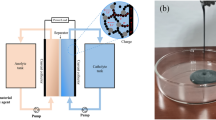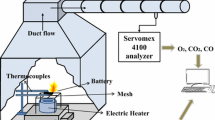Abstract
Semi-solid lithium slurry battery is an important development direction of lithium battery. It combines the advantages of traditional lithium-ion battery with high energy density and the flexibility and expandability of liquid flow battery, and has unique application advantages in the field of energy storage. In this study, the thermal stability of semi-solid lithium slurry battery material system was investigated for the first time employing C80 micro-calorimeter. In this new electrode material system, the heat generation of the electrolyte is the decisive factor for its thermal stability. Then, the measurement of in-situ dynamic cycle heat generation of semi-solid lithium slurry battery indicated a lower heat generation than traditional lithium-ion battery. What’s more commendable is that its electrochemical performance is basically the same as traditional lithium-ion battery. In addition, through the HPPC test, the mechanism of semi-solid lithium slurry battery cycle heat generation was explained. So, in this work, a preliminary evaluation on the safety and cycling stability of semi-solid lithium slurry battery is carried out. The electrochemical performance test affirms the application prospects of semi-solid lithium slurry battery, and the evaluation on the fire safety provides a reference for the future industrial applications of semi-solid lithium slurry battery.










Similar content being viewed by others
References
Masmoudi A, Abdelkafi A, Krichen L (2011) Electric power generation based on variable speed wind turbine under load disturbance. Energy 36:5016–5026. https://doi.org/10.1016/j.energy.2011.05.047
Hongyan W, Jingmin L, Qun Z, Yingji L (2009) Resources and development of new energy in China. Acta Petrolei Sin 30:469–474
Niknam T, Kavousifard A, Tabatabaei S, Aghaei J (2011) Optimal operation management of fuel cell/wind/photovoltaic power sources connected to distribution networks. J Power Sources 196:8881–8896. https://doi.org/10.1016/j.jpowsour.2011.05.081
Dandan L, Yongchong C, Han H, Yingyuan H, Hao L, Bin Z (2018) Scientific fundamentals of lithium slurry battery. Prog Chem 30:765
Hamelet S, Tzedakis T, Leriche J-B, Sailler S, Larcher D, Taberna P-L, Simon P, Tarascon J-M (2012) Non-aqueous Li-based redox flow batteries. J Electrochem Soc 159:A1360. https://doi.org/10.1149/2.071208jes
Huang Q, Li H, Grätzel M, Wang Q (2013) Reversible chemical delithiation/lithiation of LiFePO4: towards a redox flow lithium-ion battery. Phys Chem Chem Phys 15:1793–1797. https://doi.org/10.1039/c2cp44466f
Jia C, Pan F, Zhu YG, Huang Q, Lu L, Wang Q (2015) High-energy density nonaqueous all redox flow lithium battery enabled with a polymeric membrane. Sci Adv 1:e1500886. https://doi.org/10.1126/sciadv.1500886
Smith KC, Chiang Y-M, Carter WC (2014) Maximizing energetic efficiency in flow batteries utilizing non-Newtonian fluids. J Electrochem Soc 161:A486. https://doi.org/10.1149/2.011404jes
Wei TS, Fan FY, Helal A, Smith KC, McKinley GH, Chiang YM, Lewis JA (2015) Biphasic electrode suspensions for Li-ion semi-solid flow cells with high energy density, fast charge transport, and low-dissipation flow. Adv Energy Mater 5:1500535. https://doi.org/10.1002/aenm.201500535
Perez-Antolin D, Trócoli R, Palma J, Ventosa E (2020) The injectable battery. A conceptually new strategy in pursue of a sustainable and circular battery model. J Power Sources 480:228839. https://doi.org/10.1016/j.jpowsour.2020.228839
Liang C, Jiang L, Ye S, Wang Z, Wei Z, Wang Q, Sun J (2021) Precise in-situ and ex-situ study on thermal behavior of LiNi1/3Co1/3Mn1/3O2/graphite coin cell: from part to the whole cell. J Energy Chem 54:332–341. https://doi.org/10.1016/j.jechem.2020.06.008
Singh M, Kaiser J, Hahn H (2016) A systematic study of thick electrodes for high energy lithium ion batteries. J Electroanal Chem 782:245–249. https://doi.org/10.1016/j.jelechem.2016.10.040
Danner T, Singh M, Hein S, Kaiser J, Hahn H, Latz A (2016) Thick electrodes for Li-ion batteries: a model based analysis. J Power Sources 334:191–201. https://doi.org/10.1016/j.jpowsour.2016.09.143
Aurbach D (1999) Nonaqueous electrochemistry. CRC Press, Berlin
Aurbach D, Zaban A, Ein-Eli Y, Weissman I, Chusid O, Markovsky B, Levi M, Levi E, Schechter A, Granot E (1997) Recent studies on the correlation between surface chemistry, morphology, three-dimensional structures and performance of Li and Li-C intercalation anodes in several important electrolyte systems. J Power Sources 68:91–98. https://doi.org/10.1016/S0378-7753(97)02575-5
Andersson AM, Herstedt M, Bishop AG, Edström K (2002) The influence of lithium salt on the interfacial reactions controlling the thermal stability of graphite anodes. Electrochim Acta 47:1885–1898. https://doi.org/10.1016/S00134686(02)00044-0
Liang C, Jiang L, Ye S, Sun J, Wang Q (2019) Comprehensive analysis on dynamic heat generation of Li Ni1/3Co1/3Mn1/3O2 coin cell under overcharge. J Electrochem Soc 166:A3369. https://doi.org/10.1149/2.0861914jes
Bernardi D, Pawlikowski E, Newman J (1985) A general energy balance for battery systems. J Electrochem Soc 132:5. https://doi.org/10.1149/1.2113792
Acknowledgements
This work is supported by the National Key R&D Program of China (No. 2019YFA0705603). Dr. Qingsong Wang is supported by Youth Innovation Promotion Association CAS (No. Y201768).
Author information
Authors and Affiliations
Corresponding authors
Ethics declarations
Conflict of interest
The authors declare that they have no known competing financial interests or personal relationships that could have appeared to influence the work reported in this paper.
Additional information
Publisher's Note
Springer Nature remains neutral with regard to jurisdictional claims in published maps and institutional affiliations.
Rights and permissions
Springer Nature or its licensor holds exclusive rights to this article under a publishing agreement with the author(s) or other rightsholder(s); author self-archiving of the accepted manuscript version of this article is solely governed by the terms of such publishing agreement and applicable law.
About this article
Cite this article
Cheng, S., Hu, Y., Jiang, L. et al. A LiFePO4 Based Semi-solid Lithium Slurry Battery for Energy Storage and a Preliminary Assessment of Its Fire Safety. Fire Technol 59, 1181–1197 (2023). https://doi.org/10.1007/s10694-022-01305-3
Received:
Accepted:
Published:
Issue Date:
DOI: https://doi.org/10.1007/s10694-022-01305-3




